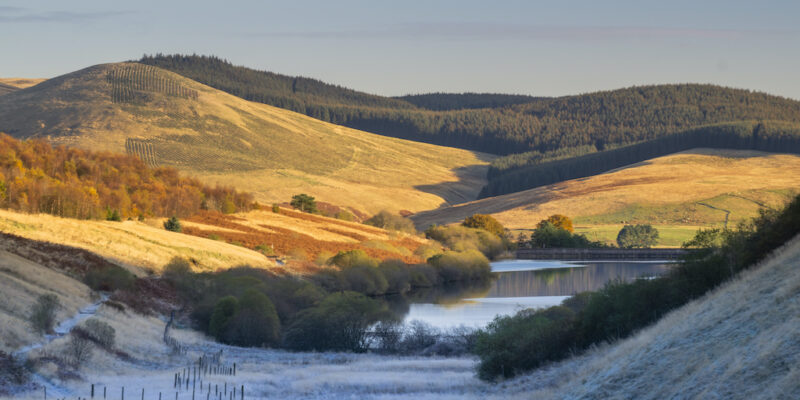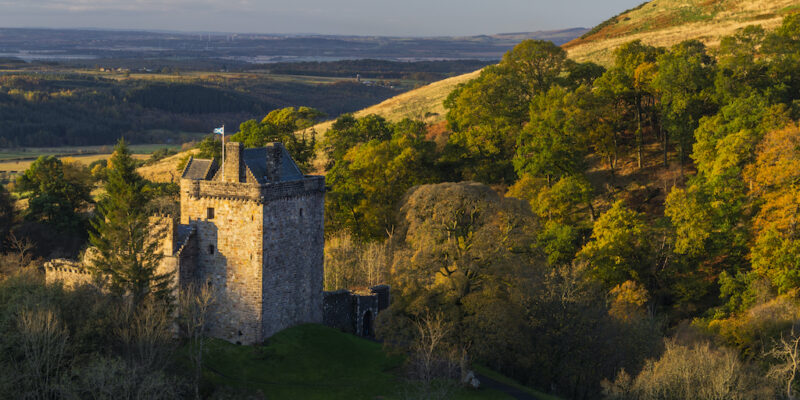High in the Ochil Hills above the Clackmannanshire town of Dollar, on a narrow isthmus between two deep rocky gorges, stands Castle Campbell, originally known as Castle Gloom, which has links to a local legend
MORE FROM SCOTLAND MAGAZINE
According to legend, the daughter of an early King of Scots was imprisoned in Castle Gloom as a punishment for falling in love with a man below her station, giving melancholy names to the surrounding features to reflect her unhappiness. Hence the evocatively named Burn of Care and Burn of Sorrow plunge over impressive waterfalls down either side of the castle before converging to form the Dollar Burn and tumble into the town below.
From Castle Campbell, an old drove road called Cadger’s Gate follows the Burn of Care through the Glen of Care into Glen Quey, and onwards to Glendevon.
Just over a mile and a half along Cadger’s Gate from the castle, in a deep and narrow pass between Whitewisp Hill and Hillfoot Hill, the track passes a small but deep spring. This spring is known as the Maiden’s Well, because, according to the story, the young lady who was imprisoned in Castle Campbell was sometimes allowed to walk to the well and drink its waters.

But the story doesn’t stop there: an article in the Scottish Journal of Topography in 1848, ‘The “Spirit” of the Well’, tells of Edwin, son of Ranald, Chieftain of Clan McCallum.
Edwin was young, athletic, handsome and accomplished, and his father’s pride and joy. On Edwin’s 21st birthday, Ranald threw open the halls of Castle Gloom to all and sundry for a great feast. As night fell, the conversation turned to the Maiden’s Well, and the water spirit that was said to haunt it. It was said that, when invoked, the spirit would rise from the well in a thin vapour and take the form of a beautiful young lady. A drunken Edwin boasted that he did not fear the spirit. He would capture it and bring it back to the castle or perish in the attempt.
It was midnight when he arrived at the well. The narrow pass was dark and silent as he called the spirit, to no avail. A second attempt proved just as fruitless. But as he demanded her presence a third time, the sprite appeared, dressed in dazzling robes, her hair cascading across her body.
Despite the alluring look she gave, Edwin went for his sword, but found himself paralysed. His strength drained, he fell dead into the water, where his corpse sunk with the spirit into the well.
Perhaps the spirit of Maiden’s Well is a guardian of Maiden Castle, a neat, round hillock a few yards along the track marking the pass between the Glen of Care and Glen Quey. Despite its name, there has never been a castle here. But according to local folklore, the hill is home to a fairy castle.

Another story goes that a piper travelling from Glendevon to Dollar one night passed the dark, featureless hill, but as he neared the Maiden’s Well, he heard music. Turning around, he saw a great castle, ablaze with lights and with the sounds of festivities echoing from within. As he stood, a company of guards emerged from the castle, captured him and took him into the castle’s Great Hall, where a huge feast was in progress. The fairies promised that they would let him go if he played his pipes for them.
He played his favourite tune and when he finished, he found himself back by the dark, silent hillock. Having been inside the castle for some time, he decided to return to Glendevon rather than continue his journey, but upon reaching his father’s house, found it to be full of strangers. On hearing his bewildered tale, an old man dozing by the fire recounted that, as a boy, his father told the story of a piper who had set off for Dollar and had never been seen since. The piper had been inside the castle for a hundred years.
Folklorist Katharine Briggs assigned this story to the international tale type of ‘The Seven Sleepers’, after the Seven Sleepers of Ephesus of Arthurian legend. Similarly, almost every body of water in Scotland is said to be inhabited by a water spirit, or kelpie, most famously at Loch Ness, and Maiden’s Well is no exception. These stories probably originated as a warning for children to keep away from water. There is also no record of Clan McCallum ever holding Castle Campbell.
So, unsurprisingly, the tales are no more than romantic folklore. The Maiden of Castle Gloom is as much a will o’ the wisp as the spirit that inhabits the spring that is named after her.
MORE FROM SCOTLAND MAGAZINE

SCOTLAND MAGAZINE
Published six times a year, every issue of Scotland showcases its stunning landscapes and natural beauty, and delves deep into Scottish history. From mysterious clans and famous Scots (both past and present), to the hidden histories of the country’s greatest castles and houses, Scotland‘s pages brim with the soul and secrets of the country.
Scotland magazine captures the spirit of this wild and wonderful nation, explores its history and heritage and recommends great places to visit, so you feel at home here, wherever you are in the world.